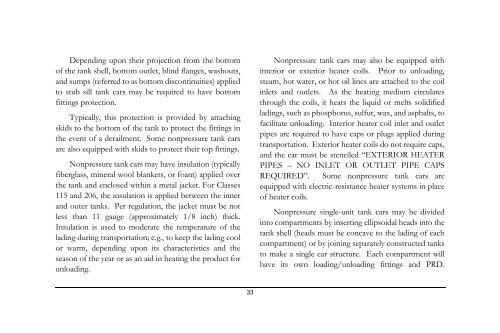Third Edition
2017%20Field%20Guide%20for%20Tank%20Cars
2017%20Field%20Guide%20for%20Tank%20Cars
Create successful ePaper yourself
Turn your PDF publications into a flip-book with our unique Google optimized e-Paper software.
Depending upon their projection from the bottom<br />
of the tank shell, bottom outlet, blind flanges, washouts,<br />
and sumps (referred to as bottom discontinuities) applied<br />
to stub sill tank cars may be required to have bottom<br />
fittings protection.<br />
Typically, this protection is provided by attaching<br />
skids to the bottom of the tank to protect the fittings in<br />
the event of a derailment. Some nonpressure tank cars<br />
are also equipped with skids to protect their top fittings.<br />
Nonpressure tank cars may have insulation (typically<br />
fiberglass, mineral wool blankets, or foam) applied over<br />
the tank and enclosed within a metal jacket. For Classes<br />
115 and 206, the insulation is applied between the inner<br />
and outer tanks. Per regulation, the jacket must be not<br />
less than 11 gauge (approximately 1/8 inch) thick.<br />
Insulation is used to moderate the temperature of the<br />
lading during transportation; e.g., to keep the lading cool<br />
or warm, depending upon its characteristics and the<br />
season of the year or as an aid in heating the product for<br />
unloading.<br />
Nonpressure tank cars may also be equipped with<br />
interior or exterior heater coils. Prior to unloading,<br />
steam, hot water, or hot oil lines are attached to the coil<br />
inlets and outlets. As the heating medium circulates<br />
through the coils, it heats the liquid or melts solidified<br />
ladings, such as phosphorus, sulfur, wax, and asphalts, to<br />
facilitate unloading. Interior heater coil inlet and outlet<br />
pipes are required to have caps or plugs applied during<br />
transportation. Exterior heater coils do not require caps,<br />
and the car must be stenciled “EXTERIOR HEATER<br />
PIPES – NO INLET OR OUTLET PIPE CAPS<br />
REQUIRED”. Some nonpressure tank cars are<br />
equipped with electric-resistance heater systems in place<br />
of heater coils.<br />
Nonpressure single-unit tank cars may be divided<br />
into compartments by inserting ellipsoidal heads into the<br />
tank shell (heads must be concave to the lading of each<br />
compartment) or by joining separately constructed tanks<br />
to make a single car structure. Each compartment will<br />
have its own loading/unloading fittings and PRD.<br />
33


